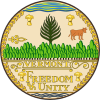List of counties in Vermont
There are 14 counties in the U.S. state of Vermont. These counties together contain 256 political units, or places, including 237 towns, 10 cities, 5 unincorporated areas, and 4 gores. Each county has a county seat, known in Vermont as shire town. In 1779, Vermont had two counties. The western side of the state was called Bennington County and the eastern was called Cumberland County.[1] In 1781, Cumberland County was made into three counties in Vermont plus another county named Washington (not the same as the modern Washington County) that then became part of New Hampshire. Today's Washington County was known as Jefferson County from its start in 1810 until it was renamed in 1814. Essex County, Orleans County, and Caledonia County are commonly called the Northeast Kingdom.
List
[change | change source]| County | FIPS Code |
Shire Town [2] |
Created [2] |
Formed from [1] |
Meaning of name [3] |
Population (2020)[2] |
Land Area [2] |
Map |
| Addison County | 001 | Middlebury | 1785 | Part of Rutland County. | Joseph Addison (1672–1719), an English politician and writer. | 37,363 | 766 sq mi (1,984 km2) |

|
| Bennington County | 003 | Bennington, Manchester |
1779 | One of the original two counties. | Benning Wentworth (1696–1770), the colonial governor of New Hampshire (1741–1766). | 37,347 | 675 sq mi (1,748 km2) |

|
| Caledonia County | 005 | St. Johnsbury | 1792 | Part of Orange County. | Latin name for Scotland. | 30,233 | 649 sq mi (1,681 km2) |

|
| Chittenden County | 007 | Burlington | 1787 | Part of Addison County. | Thomas Chittenden (1730–1797), first governor of Vermont (1791–1797). | 168,323 | 537 sq mi (1,391 km2) |

|
| Essex County | 009 | Guildhall | 1792 | Part of Orange County. | Essex, a county in England. | 5,920 | 663 sq mi (1,717 km2) |

|
| Franklin County | 011 | St. Albans (city) | 1792 | Part of Chittenden County. | Benjamin Franklin (1706–1790), one of the most revered Founding Fathers of the United States. | 49,946 | 631 sq mi (1,634 km2) |

|
| Grand Isle County | 013 | North Hero | 1802 | Part of Chittenden County and Franklin County. | Largest island in Lake Champlain. | 7,293 | 82 sq mi (212 km2) |

|
| Lamoille County | 015 | Hyde Park (town) | 1835 | Parts of Chittenden County, Franklin County, Orleans County and Washington County. | La Mouette (meaning the seagull), named by French explorer Samuel de Champlain (~1570–1635) but written as La Mouelle by mistake, and later corrupted to current spelling. | 25,945 | 462 sq mi (1,197 km2) |

|
| Orange County | 017 | Chelsea | 1781 | Part of Cumberland County. | Prince William (1650–1702) of Orange. | 29,277 | 687 sq mi (1,779 km2) |

|
| Orleans County | 019 | Newport (city) | 1792 | Part of Chittenden County and Orange County. | City of Orléans, France. | 27,393 | 695 sq mi (1,800 km2) |

|
| Rutland County | 021 | Rutland (city) | 1781 | Part of Bennington County. | Town of Rutland, Massachusetts. | 60,572 | 930 sq mi (2,409 km2) |

|
| Washington County | 023 | Montpelier | 1810 | Parts of Orange County, Caledonia County, and Chittenden County. | George Washington (1732–1799), first President of the United States (1789–1797). | 59,807 | 687 sq mi (1,779 km2) |

|
| Windham County | 025 | Newfane | 1779[a] (as Cumberland County) (renamed 1781) |
One of the original two counties. | Town of Windham, Connecticut. | 45,905 | 785 sq mi (2,033 km2) |

|
| Windsor County | 027 | Woodstock | 1781 | Part of Cumberland County. | Town of Windsor, Connecticut. | 57,753 | 970 sq mi (2,512 km2) |

|
Notes
[change | change source]- a There are several sources that state the formation year for Windham County is 1781 and that Cumberland County was dissolved rather than renamed.[4]
References
[change | change source]- ↑ 1.0 1.1 "Vermont County Information". Genealogy Trails. Retrieved 2007-07-22.
- ↑ 2.0 2.1 2.2 2.3 National Association of Counties. "NACo County Explorer". Retrieved January 18, 2024.
- ↑ Kane, Joseph; Aiken, Charles (2004). The American Counties: Origins of County Names, Dates of Creation, and Population Data, 1950-2000. Scarecrow Press. ISBN 0810850362.
- ↑ "Vermont: Consolidated Chronology of State and County Boundaries". The Newberry Library. 2008. Archived from the original on 2012-02-24. Retrieved 2009-06-03.

